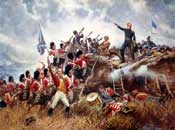New Orleans - Louisiana Historic Site

Battle of New Orleans
The War of 1812 had already ended with the signing of the Treaty of Ghent between the U.S. and Great Britain on December 24, 1814- but no one told General Andrew Jackson. The pace of news travel was slow across the Atlantic and Jackson had no idea that the war was over when he gathered up a rag-tag group of Choctaw Indians, free blacks and local militia to help defend the port of New Orleans from an attack by the British. Even pirates got into the act. Jean Lafitte- a notorious pillager of ships around the Caribbean agreed to fight in the defense of the city- possibly because it was a major source of cargo for vessels which he looted. In short, Andrew Jackson’s team was an improbable mixture of non-soldiers who stood ready to withstand an attack from the most powerful military in the world.
The British knew that they could conquer the Americans in several ways. One of them was to starve them into submission by blockading their major ports. The strategy had been working, with a blockade of the East Coast decimating American trade between 1811- 1814. As the entryway to the Mississippi- the nation’s lifeline of commerce- they wanted to shut down the port of New Orleans and deal a devastating blow to their enemy. The first skirmishes around the city began in late December 1814, with as many as 14,000 British soldiers along with support from warships off the coast ready to annihilate the Americans. On December 22nd, the hostilities began, with cannonades causing over 200 casualties on both sides. The British called their opponents the “dirty shirts” due to their unkempt, backwoods appearance. After the first battle and the large number of losses, they began to view them differently. Both sides regrouped, ready to clash again.
On January 8, 1815, Jackson again rallied his “freemen of color” and all others who would join him to defend the city. The British didn’t fully comprehend the fact that they were about to enter more deeply into a type of combat they were not used to. Jackson’s men didn’t wear bright uniforms or march in straight lines. The British did- to their detriment. As they marched forward under General Pakenham, the British were met with an overwhelming barrage of cannonballs, grapeshot and other projectiles. Their losses were equally immense- over 2,000 casualties versus just over 50 for the Americans. General Pakenham was killed… and the British began a retreat. The Battle of New Orleans had been won- and America found a new hero- General Andrew Jackson, who would become President 13 years later. Today the Battle of New Orleans is commemorated at the Jean Lafitte National Historic Park and Preserve which includes the Louisiana Wetlands at Bataria Preserve, Chalmatte Battlefield, a variety of Acadian Cultural Centers and the city of New Orleans.
